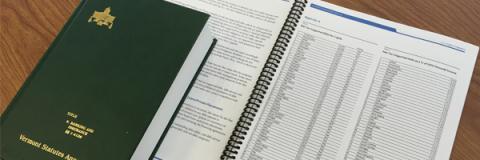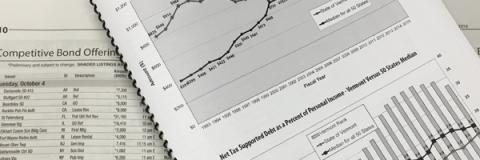Table of Contents
Membership in the System
Member and State Contributions
Retirement Service Credit
Eligibility for Retirement
Retirement Benefits Calculation
Survivor Benefits after Death in Service
Retirement Options
Cost of Living Adjustment
Purchasing Credit
Employment After Retirement
Applying for Benefits
Portability
Other Benefit and Survivor Benefits
Membership in the System
If you are a supreme court justice, superior judge, district judge, environmental judge, or probate judge, you are a Group D member.
Member and State Contributions
Group D members make annual contributions equal to 6.65% of pay into the trust fund, which is administered by the Board of Trustees. Earnings on trust fund investments provide a portion of your benefit, and the State of Vermont makes a contribution to pay the balance of your benefit.
Employee Contribution Rates in effect for FY2025 can be here.
Retirement Service Credit
You will receive retirement service credit for the full time that you are employed and are enrolled as an active member in the System. Each time you receive a paycheck you will be credited with one twenty-sixth of a year of credit. If you are off payroll for two paychecks, for example, you will receive credit for that year for .923077 years. If you work part-time and receive a check every two weeks, you will accrue credit at the full rate; your lower gross earnings for the year will be reflected in a lower retirement benefit.
You will lose your retirement service credit and any retirement benefit if you terminate and withdraw your accumulated contributions. Once you have terminated employment and have been inactive for three years, we will contact you to either vest your account or withdraw your accumulated contributions. If you have fewer than five years of service, you must withdraw your contributions. Once you have five years of service, you are vested and cannot lose your credit unless you withdraw your contribution balance. Once contributions are withdrawn, all retirement service credit is lost. However, if you have five or more years of service and leave your contributions in the System, you are guaranteed a retirement benefit at age 62. All you need to do is contact the retirement office a few months before your 62nd birthday for an estimate and application forms.
Eligibility for Retirement
Normal Retirement
You are eligible to receive a normal retirement benefit when you reach age 62 and have five years of service.
Early Retirement
You are eligible for an early retirement benefit once you have completed five years of service and have attained age 55 or have completed 30 years of service. If you terminate service before age 55 without 30 years of service, you are not eligible for early retirement benefits, although you may be eligible for vested benefits.
Disability Retirement
There are two forms of disability retirement: service-connected disability and ordinary disability. With a service-connected disability, there is no minimum service requirement; the Board of Trustees determines if you are disabled (as the result of an on-the-job injury) on the basis of medical evidence. For ordinary disability there are two requirements: the Board of Trustees must determine you are disabled on the basis of medical evidence, and you must have at least five years of creditable service. You should contact the retirement office if you have any questions concerning disability benefits or the application process.
Retirement Benefits Calculation
Normal Retirement
The amount of your pension is determined by your salary and your creditable service at retirement or termination. To calculate your annual normal retirement benefit without the survivorship reduction, multiply your Group D service times .0167 times your salary at retirement.
Supreme court justices, superior court judges, and district judges with 12 years of service receive a minimum allowance of .0333 times salary at retirement times Group D service. The total benefit is limited to 100% of salary.
Probate judges with 12 years of service receive the same minimum benefit.
For example, if your salary at retirement is $62,000, and you have 20 years of Group D service, your maximum benefit would be calculated as:
.0333 x 20 x $62,000
equals
$41,292 annually or about $3,441 a month.
This benefit is paid in full for your life or may be reduced to provide a survivor benefit as explained in Retirement Options.
Early Retirement
If you are age 55 and have at least five years of service or have a total of 30 years of service, you can take early retirement. Your benefit is calculated the same as a normal retirement benefit, but a reduction of 3% for every year you are under age 62 (or ¼% for every month you are under age 62) is applied. For instance, if you have a salary of $60,000 and are age 58 at retirement with 25 years of Group D service, the early reduction factor would be .88 and your benefit would be:
.0333 x 25 x $60,000 x .88
equals
$43,956 annually or about $3,663 a month.
Disability Retirement
If you are unable to perform your duties because of a disability which is likely to be permanent, you may apply for an ordinary disability retirement benefit if you have five years of service. If the disability is the result of a work-related injury, then there is no service requirement. Your disability benefit is calculated the same way as a normal benefit, except there is a minimum benefit payable of 25% of your AFC.
Vested Benefit
If you have five or more years of service and leave state employment before early retirement, you are entitled to a vested retirement benefit, provided that you do not withdraw your contributions. Your vested retirement benefit is payable to you at normal retirement age. Please contact the retirement office for a retirement estimate. If you are much younger than age 62 and would rather have a return of your contributions plus accumulated interest, you may request a refund which cancels your retirement service credit and any right to future retirement benefits.
Survivor Benefits After Death In Service
Eligibility
If you die as a member before termination or retirement and have 10 years of service or are age 62, a benefit is payable to your dependent beneficiary.
Amount of Survivor Benefit
The benefit payable to your dependent beneficiary is calculated as if you had retired on the date of death and had chosen the 100% Survivorship option. Your dependent beneficiary may choose to receive immediate benefit payments, defer benefit payments to a later date, or receive a refund of contributions in lieu of the survivor benefit.
Other
If you are do not meet the eligibility requirements for a survivor benefit or do not have a dependent beneficiary, the lump sum value of your contributions and interest will be paid to your designated beneficiary or your estate.
Retirement Options
Basic Benefit
The basic or maximum benefit, is payable for your life with no benefit or refund of contributions at your death. At retirement you may choose to have a reduced benefit in order to provide continued income to your spouse or other beneficiary should you predecease your beneficiary. Besides the basic benefit, you have several options from which to choose as outlined below.
Option 1
In a contributory system, there will always be accumulated member contributions on your account. By taking Option 1, the guaranteed return, you receive a benefit slightly lower than the basic benefit, but the balance of your accumulated contributions at retirement, less the sum of annuity payments made to you, will be paid in a lump sum to your designated beneficiary. This option generally results in a payment if you die within thirteen or fourteen years after retirement.
Option 2
Eliminated by the State Legislature on July 1, 2009.
100% Survivorship
This option provides for your beneficiary to receive the same monthly allowance for life that you were receiving, should you predecease your designated beneficiary. The reduction for the 100% survivorship option from the basic benefit averages between 10% and 25%, depending upon the difference in your ages.
100% Survivorship Pop-Up
The pop-up option provides a benefit that is slightly lower than the straight survivorship option, but allows for an increased payment equal to your basic benefit to you should your beneficiary predecease you, or based on the stipulations contained in a domestic relations order.
50% Survivorship
This option differs from the 100% survivorship in that your beneficiary receives 50% of the benefit that you were receiving should you predecease your designated beneficiary, therefore the reduction from the basic benefit is less. The reduction averages between 5% and 15% depending on the difference in your ages.
50% Survivorship Pop-Up
As in the earlier option, this pop-up option provides lower initial payments to you and your beneficiary, but with an increased benefit should your beneficiary die first, or based on the stipulations contained in a domestic relations order.
Examples of Survivorship Options
Option Amount Payable to Retired Amount Payable to Retired
Member (retired at age 62) Member (retired at age 62)
Basic Benefit $1,000 $0
100% Survivorship
Regular $779 $779
Pop-Up $753* $753
50% Survivorship
Regular $876 $438
Pop-Up $859* $430
*If beneficiary dies first, the member's benefit pops up to $1,000 in this case.
Level Income Option
When you are age 62, you will probably be eligible to receive a Social Security retirement benefit. Some members, however, retire before reaching age 62 and would like to increase their benefit through the Level Income Option. Under this option, a member elects to receive a percentage of the member's estimated Social Security benefit from the Retirement System before Social Security actually begins, and then pays the System back for the months of prepayment the member has received. Actual Social Security benefits you receive will not affect the Level Income Option after the initial calculations are made.
For example, suppose you have received an estimate from the Social Security Administration that your benefit at age 62, if you retire now, will be $600 monthly, and suppose your retirement benefit from the System is $800 monthly. Under this option a percentage of the estimated Social Security benefit based upon your age (the younger you are, the smaller the percentage), is added to your retirement benefit. If you were age 59, for example, with the above $600 estimate from Social Security, $460 would be added to your retirement benefit and you would receive a total of $1,260 monthly from the System until you reach 62. At age 62, $600 would be subtracted from your monthly amount and you would receive $660 thereafter. The $600 from Social Security keeps your total income "level", so you will receive a total of $1,260 each month from the System and Social Security.
If you also elect a survivorship option, the survivor benefit is paid based on your benefit before adjustments for the Level Income Option. On an actuarial basis, the Level Income Option is cost neutral. It sometimes allows a member to retire when retirement would otherwise be impossible, but if the member lives far beyond age 62, the option may have been a poor choice since the reduction in benefit after age 62 will continue for as long as you live.
Cost-of-Living Adjustment (COLA)
Purchasing Credit
You may purchase retirement credit for a number of situations, including: service in the military, in the Peace Corps, or in VISTA; as an employee in another state or municipality; teaching; and with the State of Vermont for which you received no retirement credit.
While the Retirement Office can readily provide you with the actual cost to make the purchase, our experience has shown that acquiring the verification or documentation of prior service can be a lengthy process. To that end, we encourage all members who are interested in following through with a purchase to begin the verification process as soon as possible. Service credit documentation must be reviewed by our office and determined eligible prior to submitting payment. Under the law purchase payments must be completed within a five-year period prior to retirement in equal annual installments. Payments must also indicate whether they are being made on a pre-tax or post-tax basis.
You will need verification of prior service for any of the above categories indicating the years you worked, position held, whether you were full-time or part-time and whether you are eligible to receive a pension associated with the service. Please complete the Application To Purchase Service Credit Form and return it to our office with the years you are interested in purchasing and the time-frame for making the purchase. Upon receipt of this information we will issue a service purchase letter including the eligible years to purchase, the purchase cost, and the time-frames associated with the purchase.
All of these purchase opportunities are cost neutral to the state. This means that you must pay the full cost of the added retirement benefit received. Total purchase for non-military service is limited to ten years' credit. Total military service cannot exceed five years, and there can be no parallel retirement rights in any other system for the credit you purchase. You should contact the retirement office for cost figures and return on investment information as well as the application procedure.
Employment After Retirement
A retired member may earn other income while they are receiving a retirement benefit, but they cannot work for the State of Vermont unless they are under contract or working as a temporary employee. (Retirement benefits for these two categories are excluded by law.) If they retire and return to work for the state as a classified or exempt employee, their retirement benefit will be frozen.
They will begin contributing on a new account, entirely separate from their initial retirement benefit. A member may, however, begin active membership in VMERS or VSTRS and continue to receive their pension in VSERS.
When they re-retire, the previously “frozen” benefit is eligible to resume. The member must submit, in writing, a request to resume their frozen benefit. If the member has reached vested status on their subsequent account, they must apply for a new retirement allowance which will be calculated as a separate benefit. Should a member not reach vested status on their subsequent account, the member’s contributions and applicable interest will be refunded or rolled over to an eligible financial institution.
When they retire again, both the "frozen" and any new benefits will be paid. Any previous optional election will remain in effect for the "frozen" benefit; they may elect a new option for the additional benefit.
Applying for Benefits
Retirement benefits are not automatic; you must apply for them. At least nine months prior to the date on which you plan to retire you should contact the retirement office for an estimate and application materials as well as health insurance and tax forms.
Most of your benefit will be taxable, but an exclusion ratio will be calculated for you so that a specified amount of your benefit will be excluded from tax, based on the total after-tax contributions you made prior to retirement. Retirement benefits are paid monthly and will always be mailed to you on the last business day of the month, starting with the end of the month in which your retirement occurs. Your retirement date is normally the first day of the month following your last day at work.
Electronic banking is mandatory for all new retirements after January 1, 1999. A retiree shall have their monthly check electronically deposited to their checking or savings account. The pension is "in the retiree's account" on the last working day of each month. A monthly statement itemizing the current and year-to-date withholdings is mailed to each retiree only when a change occurs in the gross or net amounts.
Remember that we are here to help you plan your retirement, so feel free to request a retirement estimate a year or two in advance to assist you in your retirement planning.
Portability
Members who leave state employment and join either the Vermont State Teachers' Retirement System or the Vermont Municipal Employees Retirement System may transfer their retirement credit to either system within one year of their new employment, and vice versa, provided that they have not received a refund of contributions or received retirement benefit payments.
Other Retirement and Survivor Benefits
Group Health Insurance
One of the more attractive benefits of the Vermont State Retirement System is your ability to carry health insurance into retirement. If you are vested at 5 years of service, upon retirement you will continue to pay 20% of the premium in retirement as you have during your active employment. You must be a covered employee at retirement and may carry whatever coverage is in effect at that time for life.
There will be a double deduction for the health premium from your first pension check, as our office needs to set the payments up in advance of the month during which the coverage occurs.
*To avoid possible issues during the transition from active employee health insurance to retiree health insurance, we strongly recommend filling any prescriptions before the end of the month in which you stop working.
After you have retired and reached age 65, Medicare coverage is mandatory and the cost is shared with the plan, so the plan premium drops; Medicare becomes the primary insurer. You must remember to enroll for both Part A and Part B of Medicare as soon as eligible. You do not need to enroll in Part D of Medicare as Express Scripts provides additional coverage that "wraps" around the standard plan, which is better than a Medicare Part D plan.
It is important to recognize that if you have two-person or family coverage, that coverage ceases at your death, unless you have chosen a survivorship option to allow for the monthly premium deduction from the beneficiary's retirement check. In this instance, the surviving beneficiary must pay the full premium cost of the health insurance. The Premium Reduction Option (PRO) gives members at retirement the option of paying a higher premium in order to provide a partial premium for their surviving dependent, if they elect a survivorship option at retirement.
Dental Insurance
At the date of retirement members are given a one time option to choose Dental Insurance at the full premium cost to the member provided they have the state dental coverage at retirement. The state does not contribute any portion of this premium. There will be a double deduction for the dental premium from your first pension check, as our office needs to set the payments up in advance of the month during which the coverage occurs.
Life Insurance
If you are covered by life insurance and have at least 20 years of creditable service and retire with no break between termination and retirement, you are covered by a $10,000 life insurance policy at no cost. Disabled members can apply prior to age 60. In addition, you may convert your present insurance coverage to an individual policy without a physical examination.
Social Security
Some retirement systems are integrated with Social Security, and the amount of one's retirement check depends upon the benefit from the federal government. Vermont's Retirement System has no effect upon Social Security and vice versa; the two supplement one another. Remember that you have to apply for both benefits, since neither is automatic.
Full Social Security is paid at ages 65 to 67, depending on your year of birth. Employees born in 1937 or earlier are entitled to full benefits at age 65; employees born in 1960 or later will be entitled to full benefits at age 67. The full benefit age gradually increases from age 65 to 67 for those born between 1938 to 1959.
Benefits can begin as early as age 62 with a 20% to 30% reduction, depending on your year of birth. The reduction is 20% for employees born in 1937 or earlier.
Deferred Compensation
Deferred compensation is a tax-sheltered vehicle which allows you to increase income at retirement. The Internal Revenue Service establishes the maximum amount that may be contributed each year. The balance in your Deferred Compensation account is payable upon termination of employment or retirement, regardless of your age. Additional detailed information about the plan may be found at the Prudential Retirement website (the deferred compensation third-party administrator for the State of Vermont) or through this web site at Deferred Compensation.
If you still have questions regarding your retirement account or other matters about retirement, please do not hesitate to contact the Retirement Office at 1-800-642-3191 (toll free within VT only) or (802) 828-2305. The staff is always happy to answer your questions and assist in your retirement planning.





